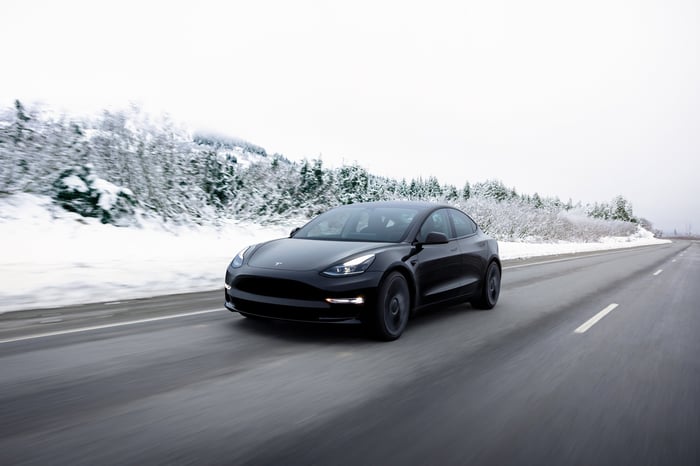
Tesla (TSLA -0.03%) hit a historic peak in December, just after President Trump’s electoral victory. Investors are optimistic about potential regulatory changes that could expedite the rollout of the company’s full self-driving (FSD) software, especially since CEO Elon Musk is currently advising the administration.
While FSD holds the promise of significantly improving Tesla’s financial structure, realizing its full potential could take years, even with a faster approval process (more details to follow). In the meantime, the company is grappling with a decline in electric vehicle (EV) sales—the primary source of its revenue.
This decline is one of the contributing factors to a 31% drop in Tesla’s stock price from its recent peak. Here’s why I foresee a potential further decrease of 50% in the next year.

Image source. Tesla.
Decline in Tesla’s Electric Vehicle Sales
Up until the close of 2023, Musk frequently assured investors of a projected 50% annual growth rate in Tesla’s EV production. The company managed to deliver 1.8 million vehicles that year, marking a 38% rise compared to 2022. Although this was short of the 50% goal, it was still a commendable performance.
However, 2024 yielded a different situation altogether. EV deliveries saw a slight decline of 1%, creating the first annual drop since the introduction of the Model S in 2011. Tesla is confronted with several difficult challenges, including fierce competition and waning demand for EVs as consumers reflect on depreciation and the availability of charging solutions.
In essence, achieving a 50% increase in production is unrealistic if sales are declining. Musk has forecasted a rebound in sales for 2025, with possible EV deliveries increasing by as much as 30%. However, the early indicators are concerning.
In January, sales plummeted by 63% in France, nearly 60% in Germany, 44% in Sweden, and 38% in Norway. Australia saw a decline exceeding 33% as well.
Adding to the issue, in Germany, overall EV sales actually rose by 53%, indicating Tesla is losing ground in market share rapidly.
The outlook appears even grimmer as more affordable EVs are introduced by budget-friendly manufacturers such as China’s BYD, which offers its Seagull model for merely $10,000 domestically and is anticipated to expand into Europe this year.
FSD and a $10 Trillion Market Opportunity
Last year, Tesla introduced its Cybercab robotaxi, set to operate using its FSD technology. Notably, this vehicle won’t require pedals or a steering wheel. Musk envisions creating a ride-hailing network where Cybercabs will transport passengers and facilitate commercial deliveries continuously, leading to a new, lucrative revenue stream for the company.
Cathie Wood’s Ark Investment Management projects that the autonomous ride-hailing market could elevate Tesla’s annual revenue to over $1.2 trillion by 2029, representing a staggering twelvefold increase from the anticipated $97.6 billion in 2024. Other financial analysts, like Dan Ives from Wedbush Securities, also forecast a trillion-dollar opportunity tied to FSD.
The Cybercab is not expected to enter mass production until 2026, delaying the realization of these projections. This brings us to another long-term prospect for Tesla—the Optimus humanoid robot—which Musk claims will have a thousandfold more applications than a vehicle.
Tesla plans to deploy thousands of Optimus robots within its manufacturing plants this year to handle repetitive and hazardous tasks that are undesirable for human workers. Given the adaptability of humanoid robots, the potential market is nearly limitless, applicable in diverse settings including factories, households, and beyond.
Moreover, with an expected price point of under $30,000, Optimus will be significantly more affordable than the annual costs associated with human labor, presenting a clear advantage for businesses worldwide.
Musk predicts that Optimus could generate $10 trillion in sales over the long term and foresees a future where robots could outnumber humans by 2040.
The High Cost of Tesla Stock: A Potential 50% Drop Ahead
In 2024, Tesla reported earnings per share (EPS) of $2.04, resulting in a remarkable price-to-earnings (P/E) ratio of 161. This astronomical valuation is particularly striking when compared to the Nasdaq 100 technology index, where the average P/E stands at just 33.6.
This valuation renders Tesla’s stock three times more expensive than that of Nvidia, which is priced at a P/E of 52.2. Nvidia is set to release its fiscal year 2025 financial results on February 26 and is predicted to have achieved an impressive 126% growth in EPS. In stark contrast, Tesla saw its EPS decline by 53% in 2024, making it incredibly challenging to justify the high premium on Tesla’s valuation today.
TSLA PE Ratio data sourced from YCharts.
Historically, Tesla stock has been known for its premium valuation compared to the broader market. This was previously validated by the incredible growth of the company’s EV segment. However, that growth trend appears to be waning.
Currently, EV sales contribute to approximately 78% of Tesla’s total revenue. Thus, the recent downturn is concerning, particularly as the company’s future growth avenues, such as autonomous driving and the Optimus robot, are not anticipated to scale up until post-2026. This suggests that investors may need to prepare for another year of diminished earnings in 2025, exacerbating the struggle to justify Tesla’s current valuation.
As mentioned earlier, Tesla’s stock has already dropped by 31% from its peak. If it were to decrease by an additional 50%, its P/E ratio would still remain above 80. It would require a 67% decline for the stock to align with Nvidia’s P/E ratio or a 79% plunge to match that of the Nasdaq 100. This assumes company earnings do not further dip, which is a feasible concern.
Consequently, I believe significant risks loom for Tesla’s stock over the coming year. Should it decline by an additional 50%, investors who are optimistic about the potential success of the Cybercab and Optimus might find a compelling long-term investment opportunity.










